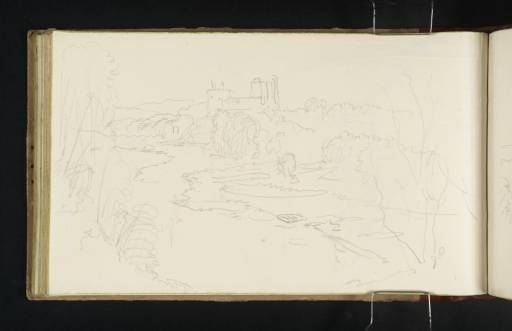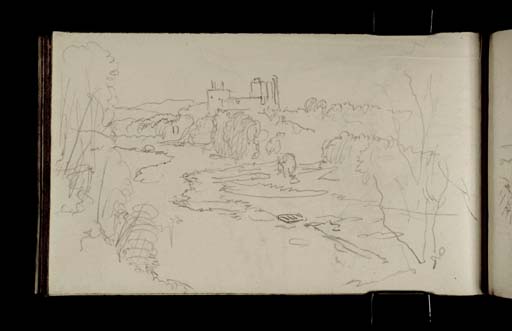Joseph Mallord William Turner Doune Castle and the River Teith from the South 1834
Image 1 of 2
Joseph Mallord William Turner,
Doune Castle and the River Teith from the South
1834
Joseph Mallord William Turner 1775–1851
Folio 52 Verso:
Doune Castle and the River Teith from the South 1834
D26358
Turner Bequest CCLXIX 52a
Turner Bequest CCLXIX 52a
Pencil on off-white wove paper, 113 x 190 mm
Accepted by the nation as part of the Turner Bequest 1856
References
1909
A.J. Finberg, A Complete Inventory of the Drawings of the Turner Bequest, London 1909, vol.II, p.866, CCLXIX 52a, as ‘Castle on hill beside river.’.
1936
Henry J. Crawford, Turner’s Sketches and Drawings of Stirling and Neighbourhood with Some Notes on the Artist’s Scottish Tours also a Note on John Ruskin and Stirling, Stirling 1936, p.27.
1990
Dr David Wallace-Hadrill and Janet Carolan, ‘Turner’s Sketches North of Stirling’, Turner Studies: His Art and Epoch 1775 – 1851, Vol.10 No.1, Summer 1990, p.12.
1990
Dr David Wallace-Hadrill and Janet Carolan, ‘Turner North of Stirling in 1831; a checklist (2)’, Turner Studies: His Art and Epoch 1775–1851, Vol.10 No.2, Winter 1990, p.29 illustrated fig.43 in black and white.
Henry Crawford was the first to suggest tentatively that this sketch may depict Doune Castle on the River Teith near Stirling,1 a suggestion confirmed by David Wallace-Hadrill and Janet Carolan.2 Turner first saw the castle in 1801 when he made sketches in the Scotch Lakes sketchbook: Tate D03199–D03202 (Turner Bequest LVI 146 verso–148). In 1834 he passed it again, perhaps twice, on a ten-day tour as part of a longer visit to Scotland; See Tour of Scotland for Scott’s Prose Work 1834 Tour Introduction. There is a long series of studies of the castle in this sketchbook on folios 34 verso, 52 verso, 53, 59, 60 verso–61 verso–64 and 65 (D26326, D26358, D26359, D26371, D26373–D26380, D26382). The sequence records the artist’s approach to the castle, his circuit around it and visit to the interior, and his onward westerly journey west towards Callander. There are also several further sketches in the Loch Ard sketchbook: Tate D26742 and D26743 (Turner Bequest CCLXXII 40, 40a).
As well as its architecture and setting, Turner may have been interested in the castle’s significance to literature and history. As one of the locations in Sir Walter Scott’s first novel, Waverley, Or ’Tis Sixty Years Hence, 1814, it is possible that the castle was considered as a subject for Turner to illustrate for Robert Cadell’s proposed new edition of the Waverley Novels.3 One of his sketches of the castle is inscribed ‘W S’, a possible reference to Walter Scott: folio 62 verso (D26377).Turner may also have been interested in the castle’s connection to Mary Queen of Scots, who stayed there on several occasions; see Tour Introduction for more information.
The sketch on the present page begins the sequence made as Turner approached the castle with a view from the River Teith to the south. Turner’s river bank viewpoint is well selected as the trees at either side of the foreground frame the view beyond with the serpentine river and the castle clearly visible above the densely wooded riverbank.
Thomas Ardill
November 2010
Wallace-Hadrill and Carolan 1990, Vol.10 No.1, p.2 and Wallace-Hadrill and Carolan 1990, Vol.10 No.2, p.29.
Doune Castle had previously been engraved as an illustration to Waverley by Edward Francis Finden after James Duffield Harding, Doune Castle, engraving, reproduced in Landscape Illustrations of the Waverley Novels, with Descriptions of the Views, 2 vols, London 1832; and James Skene, Doune Castle, etching, reproduced in A Series of Sketches of the Existing Localities alluded to in the Waverley Novels Etched from Original Drawings, Edinburgh 1829.
How to cite
Thomas Ardill, ‘Doune Castle and the River Teith from the South 1834 by Joseph Mallord William Turner’, catalogue entry, November 2010, in David Blayney Brown (ed.), J.M.W. Turner: Sketchbooks, Drawings and Watercolours, Tate Research Publication, December 2012, https://www


